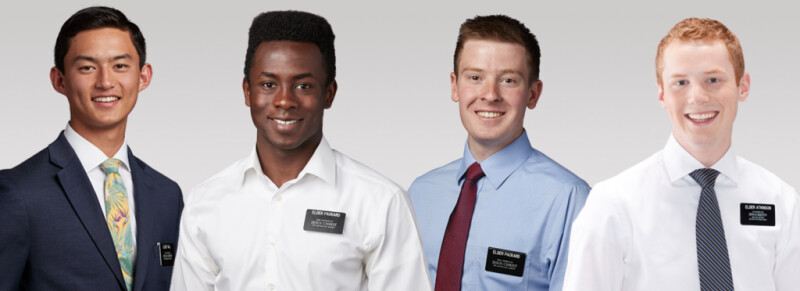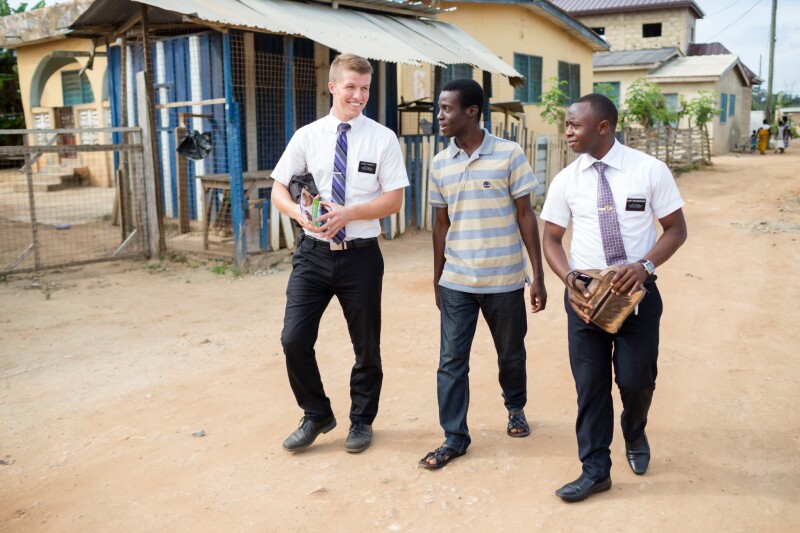During the opening session of general conference in October 2012, President Monson made a historic announcement, lowering the minimum age requirement for full-time missionaries: young women could begin serving at age 19 rather than 21, and young men at age 18 instead of 19. Since that unprecedented change, there have been many other important changes and updates to Church missionary service. Here’s a timeline of the most significant and substantial updates affecting missionaries over the last decade.
Early 2013: Missionaries began social media proselyting
Missionaries in the New York Rochester Mission began exploring the use of social media for missionary work in March 2010, according to Church News. When Michael Hemingway, president of the New York Rochester Mission, returned home and began working for the Missionary Department, he shared what he learned with department leadership, and a strategy was rolled out for missionaries to use Facebook and digital devices for proselyting and communication. In 2014, 20 missions were using social media. By 2015, the program expanded to 80 missions and later to 160 missions within just a few years.
Summer 2013: Provo MTC “West Campus” was established
To house the huge increase of new full-time missionaries, two apartment complexes about a mile away from the main Provo MTC campus were leased for missionary training and housing.
April 2013: New mission leadership council roles were established
Due in part to the influx of thousands of young missionaries responding to the lowered age requirements, the Church announced that a new missionary leadership council was to be organized in each mission. This council now includes the mission president and his wife, assistants to the president, zone leaders, and a new role: sister training leaders.
April 2013: 58 new missions were created
In his opening remarks of the 2013 April general conference, President Thomas S. Monson said, “We have 65,634 full-time missionaries serving, with over 20,000 more who have received their calls but who have not yet entered a missionary training center, and over 6,000 more in the interview process with their bishops and stake presidents. It has been necessary for us to create 58 new missions to accommodate the increased numbers of missionaries.”
Of the 58 newly-created missions, 7 were in Brazil, 8 in Mexico, 4 in the Phillippines, and 5 in Africa.
November 2014: The Provo MTC “West Campus” closes
The Raintree Apartments and BYU-owned WyView Park, spaces that were used to house and teach additional missionaries in 2013, were no longer used for missionary purposes and resumed housing college students.
October 2017: The new Provo MTC was dedicated
The newly dedicated Provo MTC campus included two six-story buildings with 200 classrooms, more than 100 practice teaching rooms, and 13 computer labs. Before his dedicatory prayer, President Henry B. Eyring said that missionaries at the MTC would learn to support each other and to listen to each other—as well as to the Holy Spirit.
June 2018: “Preach My Gospel” was updated
A new edition of the Church’s guide to missionary service, “Preach My Gospel,” is announced. The new updates included a reduction in the number of “key indicators” missionaries record and report and replaced outdated references to “home and visiting teaching” with “ministering.”
September 2018: Mission calls now delivered electronically
As reported by Church News, “The new, online call letter process will also allow missionaries to speed up possible visa applications and to often report earlier to their assigned missionary training center.”
December 2018: New attire and grooming guidelines for sister missionaries
A First Presidency letter announced that Latter-day Saint sister missionaries can wear dress pants during regular missionary activities and at missionary training centers.
February 2019: Several international MTCs close
The Church’s Missionary Training Centers in Spain, Chile, Argentina, and the Dominican Republic closed, due in part to the capacity of the new Mexico City MTC. The Guatemala MTC closed in September 2019 as well.
► You may also like: Where in the world are the Church’s 10 MTCs?
February 2019: Updates made to missionary communication with family
The First Presidency announced that missionaries could call and text home weekly. “Regular communication with their families is an important part of a missionary’s service,” the First Presidency said. “One of the major purposes of this adjustment is to encourage families to be more involved in their missionary’s efforts and experiences.”
November 2019: Missionary handbook was updated
The “Missionary Standards for Disciples of Jesus Christ” was updated for the first time since 2010. Missionaries commonly use this handbook for guidance on dealing with a variety of situations, and this new version includes additions about enhanced missionary safety, cultural sensitivity, using technology, and managing stress and mental health challenges.
January 2020: All missionaries approved to have access to a smartphone
Under the direction of President Nelson, approval was given for every missionary for the Church of Jesus Christ of Latter-day Saints to have access to a smartphone. Elder Brent H. Nielson later told Church News, “Way back in 2014, under the direction … of the Quorum of the Twelve Apostles, we had begun the process of figuring out how to do missionary work using these devices. When the world closed down, our missionaries stepped forward and performed a miracle.”
February 2020: Missionary evacuations began due to COVID-19
Beginning in February and over the course of the next several months, many missionaries were sent home. In March 2020, the First Presidency announced that “substantial numbers of missionaries will likely need to be returned to their home nations to continue their service.”
March 2020: MTC training became remote due to COVID-19
A statement from the First Presidency said that “Missionary training centers (MTCs) worldwide will not receive new missionaries. MTC training for missionaries will take place through technology, and missionaries will be sent to their assigned mission as soon as possible.”
► You may also like: Why I consider my virtual MTC experience a blessing
March 2020: New service options for missionaries due to COVID-19
In a Church Newsroom statement, the First Presidency announced that missionaries can be temporarily released, reassigned, or choose to delay their service. You can read the full announcement here.
June 2020: New attire exceptions for missionaries

Exceptions were approved by the First Presidency for Area Presidencies to adjust missionary attire “to improve and maintain missionary dignity, safety, effectiveness, approachability, and cultural sensitivity while properly representing the Lord and His Church.” These approved exceptions include blue shirts and no ties.
November 2020: Missionaries receive assignments to serve beyond home countries again
Church Spokesman Daniel Woodruff announced that missionary assignments are “deliberate and cautious” and that “the safety of our missionaries and those they serve is our top priority.”
June 2021: MTCs reopen with hybrid in-person/online training
The Church’s Missionary Training Centers in Ghana, Provo, and New Zealand all resumed limited on-site training. More international MTCs resumed in-person training over the following months.
Today, most missionaries’ MTC experiences are still a hybrid of virtual and in-person training—half of their time is spent at home participating in online lessons, and the other half of the time is spent living and learning on-site at one of the Church’s 10 MTCs around the world.
June 2023: Second Edition of “Preach My Gospel” was released
On June 22, 2023, President Russel M. Nelson announced a second edition of Preach My Gospel saying, “It contains some of the best instruction I have ever seen to help people accept the Lord’s invitation to come unto Him.” The new subtitle, “A Guide to Sharing the Gospel of Jesus Christ” highlights that this new version isn't just for missionaries, but for members too.
▶You may also like: 7 updates in the new ‘Preach My Gospel’ that can improve your approach to missionary work


